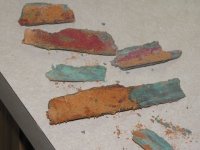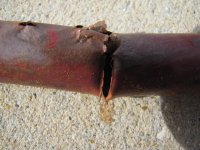I have a problem which has me a bit puzzled, and although it is not directly C Dory related, I hope that some of the members have some good ideas as to what is causing the problem.
Several days ago I noted a warm area of the utility room floor. Yesterday evening: no hot water or water pressure. We shut off the hot water and this AM "American Leak Detectors" pinpointed the leak ($285 right where it was hot several days ago).
The plumber was here for about 4 hours, and the 3/4 inch soft copper hot water pipe buried 6" under the 5" re-inforced slab is completely shot. It looks like bark peeling off a tree. The house is only 8 years old. The cold water pipe is fine. We are going to have to replumb the entire hot water system--through the atic. This is a 3600 sq foot 4 bath house, with some ceilings as high as 16 feet, so not an easy job. But that is life.
The plumber thinks it was a lightning strike. I think perhaps some form of electrolysis. Any thoughts:

Several days ago I noted a warm area of the utility room floor. Yesterday evening: no hot water or water pressure. We shut off the hot water and this AM "American Leak Detectors" pinpointed the leak ($285 right where it was hot several days ago).
The plumber was here for about 4 hours, and the 3/4 inch soft copper hot water pipe buried 6" under the 5" re-inforced slab is completely shot. It looks like bark peeling off a tree. The house is only 8 years old. The cold water pipe is fine. We are going to have to replumb the entire hot water system--through the atic. This is a 3600 sq foot 4 bath house, with some ceilings as high as 16 feet, so not an easy job. But that is life.
The plumber thinks it was a lightning strike. I think perhaps some form of electrolysis. Any thoughts:



